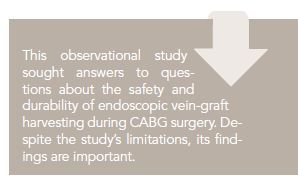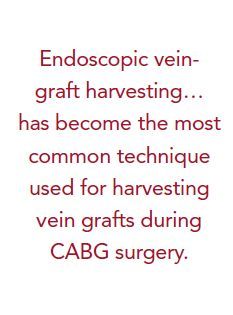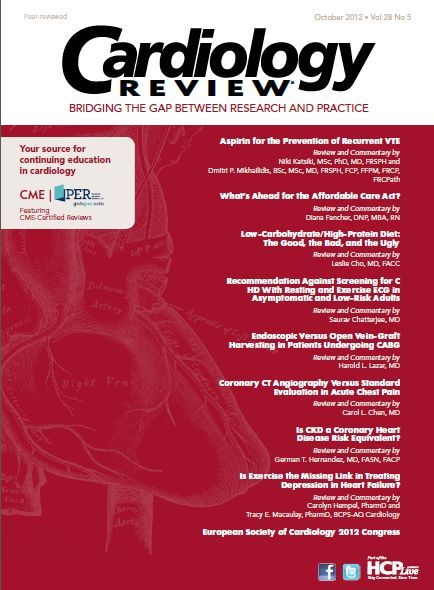Publication
Article
Endoscopic Versus Open Vein-Graft Harvesting in Patients Undergoing CABG

Review

Endoscopic vein-graft harvesting has emerged as an alternative to open techniques for the procurement of saphenous vein grafts during coronary artery bypass graft surgery (CABG). Because it has been associated with a lower incidence of wound complications and infections, it has become the most common technique used for harvesting vein
grafts during CABG surgery.1
Randomized trials have shown that the endoscopic technique had no detrimental effects on endothelial histology or function and no difference in shortterm vein graft patency.2-4 However, in 2009, CABG patients enrolled in the Prevent IV (Project of Ex-Vivo Vein Graft Engineering via Transfection IV) trial, which investigated the effect of edifoligide delivered under pressure to saphenous veins, had a significantly higher risk of 1-year angiographic veingraft failure and higher 3-year mortality with endoscopic vein harvesting than those receiving the open vein-grafting technique.5 This prompted the US Food and Drug Administration to ask for an analysis of the Society of Thoracic
Surgeons (STS) Adult Cardiac Surgery Database (ACSD) to determine whether the endoscopic technique increased the risk for death, myocardial infarction
(MI), and the need for repeat revascularization in CABG patients.
Study Details

To answer questions about the safety and durability of endoscopic vein-graft harvesting during CABG surgery, Williams and co-workers performed an observational study in 235,394 Medicare patients undergoing isolated first-time CABG surgery between 2003 and 2008 at 934 surgical centers participating in the STS national database.6 The STS records were linked to Medicare files to allow longitudinal assessment (median 3-year follow-up) through December 31, 2008. Propensity scores with inverse probability weights were developed to adjust for differences in baseline characteristics between the 2 treatment groups. The primary outcome was allcause mortality. Secondary outcomes included wound complications, and the composite end point of death, MI, and the need for repeat revascularization.
Overall, 52% of the vein-graft harvests were performed using the endoscopic technique. The incidence of endoscopic harvesting increased over time such that in 2008, 70% of the vein-graft harvests were performed endoscopically. There were no significant differences between long-term mortality rates (13.2% vs 13.4%) and the composite end point of death, MI, and the need for repeat revascularization between the open and endovascular techniques. However, endoscopic vein-graft harvesting was associated with a lower incidence of wound complications (3.0% vs 3.6%; P <.001).
The authors concluded that in this cohort of patients undergoing CABG surgery, the use of endoscopic veingraft harvesting was not associated with increased mortality, MIs, or the need for repeat revascularization, but did significantly decrease the incidence of wound infections compared with the traditional open technique.
References
1. Bitondo JM, Daggett WM, Torchina DF, et al. Endoscopic vs. open saphenous vein harvest: a comparison of postoperative wound complications. Ann Thorac Surg.
2002;73: 523-528.
2. Perrault LP, Jeanmart H, Bilodeau L, et al. Early quantitative coronary angiography of saphenous vein grafts for coronary artery bypass grafting harvested by means of open
vs. endoscopic saphenectomy: a prospective randomized trial. J Thorac Cardiovasc Surg. 2004;127:1402-1407.
3. Griffith L, Allen KB, Waller BD, et al. Endoscopic and traditional saphenous vein harvest: a histological comparison. Heart Surg Forum. 1999;2:S64.
4. Black EA, Guzik TJ, West NE, et al. Minimally invasive saphenous vein harvesting: effects on endothelial and smooth muscle function. Ann Thorac Surg. 2001;71:1503-1507.
5. Lopes RD, Hafley GE, Allen KB, et al. Endoscopic versus open vein-graft harvesting in coronary-artery bypass surgery. N Engl J Med. 2009;361:235-244.
6. Williams JB, Peterson ED, Brennan JM, et al. Association between endoscopic vs. open vein graft harvesting and mortality, wound complications and cardiovascular effects in patients undergoing CABG surgery. JAMA. 2012;308:475-484.
7. Allen KB, Griffith GL, Heimansohn DA, et al. Endoscopic versus traditional saphenous vein harvesting: a prospective, randomized trial. Annals Thorac Surg. 1998;66:26-31.
8. Allen KB, Heimansohn DA, Robison RJ, Schier JJ, Griffith GL, Fitzgerald EB. Influence
of endoscopic vs. traditional saphenectomy on event-free survival: five-year followup of a prospective, randomized trial. Heart Surg Forum. 2003;6:E143-E145.
9. Perrault LP, Kollpainter R, Page P, Miles RG, Tanguay D, Carrier M. Techniques, complications, and pitfalls of endoscopic saphenectomy for coronary artery bypass
grafting surgery. J Card Surg. 2005;20:393- 402.
10. Dacey LJ, Braxton JH, Cramer RS, et al; Northern New England Cardiovascular Disease Study Group. Long term outcomes of endoscopic vein harvesting after coronary artery bypass grafting. Circulation. 2011;123:147-153.
11. Shroyer AL, Grover FL, Hatler B, et al; Veterans Affairs Randomized On/Off Bypass (ROOBY) Study Group. On pump vs. off pump coronary artery bypass surgery. N
Engl J Med. 2009;361:1827-1837.
12. Chavanon O, Tromblay I, Delay D, Bouveret A, Blain R, Perrault LP. Carbon dioxide embolism during endoscopic saphenectomy for coronary artery bypass graft surgery.
J Thorac Cardiovasc Surg. 1999;118:2015-2016.
13. Banks TA, Manetta F, Glick M, Graver LM. Carbon dioxide embolism during minimally invasive vein harvesting. Ann Thorac Surg. 2002;73:296-297.
CommentaryEndoscopic Vein-Graft Harvesting: Limitations But a Breakthrough Nonetheless
Leg wound complications, notably infections, hematomas, and pain are an important source of morbidity after open harvesting of saphenous vein grafts, and may occur in up to 28% of patients.1 This contributes to overall increased length of hospital stay and patient dissatisfaction, and increases the costs of CABG surgery. Patients who are now angina free may still complain of the edema, erythema, and discomfort from their saphenous vein-graft harvest sites. In an attempt to avoid the side effects of open harvest techniques, surgeons began using endoscopic vein-graft harvesting techniques in the mid 1990s.7
Concerns were raised that endoscopic harvesting might injure vein grafts. There was a theoretical risk of endothelial denudation injury, which might alter endothelial function, thus increasing vascular inflammation and reducing vein graft patency. Furthermore, the technique involved more manipulation of the vein than was seen using
“no-touch” open techniques. Despite these concerns, Perrault and co-workers found no difference in short-term (3 months) saphenous vein-graft patency between the open and endoscopic techniques.2 Other studies comparing the histology and function of the endothelium could find no detrimental effects of endoscopic vein harvesting.3,4 Allen
and co-workers found that CABG patients randomized to endoscopic versus open vein-graft harvesting techniques
had similar 5-year rates of death, MI, and recurrent angina.8
It soon became obvious that endoscopic vein harvesting significantly decreased the incidence of leg wound complications seen with the open technique. Perrault and co-workers reported a decreased rate of wound infections, less postoperative pain, and superior cosmesis and patient satisfaction using the endovascular harvesting
technique.9 By 2008 the STS database reported that 70% of all saphenous vein-graft harvests for CABG surgery were performed using the endoscopic technique.6
In 2009, a large observational study called into question the safety of the endovascular vein-graft harvesting technique.5 The PREVENT IV trial found that patients who had received endoscopic vein grafting had a higher 1-year angiographic vein graft failure rate and higher 3-year mortality rate than those receiving open techniques.
There were, however, several issues of concern associated with this study. The results were derived from an ad hoc analysis, which was not the primary intent of the trial. The incidence of vein graft failure was the highest ever reported in a clinical trial, calling into question 2 important interventions that were performed on these veins. All the veins in the study were subjected to ex-vivo manipulation with pressurized techniques to deliver the study drug or placebo. Over-distension of the vein graft accelerates the denudation of the endothelium, exposing it to increased rates of intimal hyperplasia, which can result in an early decline in patency. Furthermore, the effect of the study drug, edifoligide, on vein graft patency was unknown. It is not surprising, then, that these vein grafts would have decreased vein graft patency.
Two other studies comparing the open and endovascular technique were reported in the same time period as the Prevent IV trial.10,11 The Northern New England group studied 8542 isolated CABG patients in whom endoscopic vein harvesting was employed in 53% of patients.10 In this study, endoscopic vein harvesting was associated with a 20% reduction in mortality at 4 years. It was not associated with a higher rate of repeat revascularization. However, in the Randomized On/Off Bypass (ROOBY) trial, endoscopic vein harvesting was associated with a lower1-year saphenous vein graft patency rate and higher 1-year revascularization rate, independent of the use of off- or on-pump CABG surgery.11

The present study by Williams and colleagues has some limitations. Although there was no increased incidence in mortality, MIs, or the need for repeat revascularization, there were no actual data to show that vein graft patency was not different between the 2 techniques. No mention is made of recurrent angina or angina class,
and there were no follow-up angiograms. Many patients can remain symptom free with just a patent left internal mammary artery to left anterior descending artery (LIMA to LAD) anastomosis and still have occluded all their vein grafts. The data reported reflects “the intention to treat” principle. If conversion from an endoscopic to an open harvest occurred, the procedure was treated as an endoscopic procedure. Hence, the true treatment intervention was not identified. The crossover rate for these techniques was not clearly identified. No mention is made regarding the use of statins or aspirin in these patients. This is an important point because these drugs can significantly affect vein graft patency, but we are not told if the incidence of the use of these agents differed among the techniques. The study was retrospective and the physicians themselves decided which harvesting technique was to be used. The follow-up was relatively short—only 3 years. Finally, there were no standardized techniques employed for either the open or the endoscopic harvesting procedures.
Based on my own experience with endovascular harvesting in my practice of CABG surgery, I would agree with the results of Williams and his colleagues. Endoscopic harvesting has resulted in a significant decrease in leg wound infections without an increased incidence of MIs or need for repeat revascularization. However, the technique does have some limitations. It takes longer and there is a steep learning curve. The instruments are disposable, which adds to the cost of the procedure. Hematomas and seromas can still occur in the tunnels used for the harvest. Carbon dixoide embolism can occur if pCO2 pressures are >15 mm Hg. This can result in a rapid rise in pulmonary artery pressures and can result in potential neurological injury if the emboli pass through a patent foramen ovale and enter the left heart chambers. 12,13 In many instances, only the thigh vein is harvested endoscopically and the distal leg is harvested using an open technique. This saves times and avoids injury to the small distal vein. Not all veins should or can be harvested endoscopically. Veins that are small in caliber, have numerous tributaries, or are superficial in relation to the skin are best harvested using an open technique. It is important that heparin be administered prior to ligating side branches to prevent small clots from developing at the junction of the vein and its branches.
Despite some of the difficulties with endoscopic vein harvesting, it represents a major breakthrough in minimizing the morbidity associated with leg vein harvesting in CABG surgery. Although there are limitations noted above to the study by Williams et al, it is reassuring to know that the decreased leg morbidity associated with this technique does not come at the expense of increased long-term mortality, MIs, or result in an increased incidence of the need for repeat revascularization procedures.
About the Author-
Harold L. Lazar, MD, is Professor of Cardiothoracic Surgery at Boston University School of Medicine and the Boston Medical Center, Boston, MA. He received his MD from Boston University, completed his residency in general surgery at the University of Michigan Medical Center in Ann Arbor, and did his cardiothoracic residency at Columbia-Presbyterian Medical Center in New York, NY. Dr Lazar has lectured widely and is the author of numerous journal articles and book chapters. He is the Editor-in-Chief of The Journal of Cardiac Surgery.
